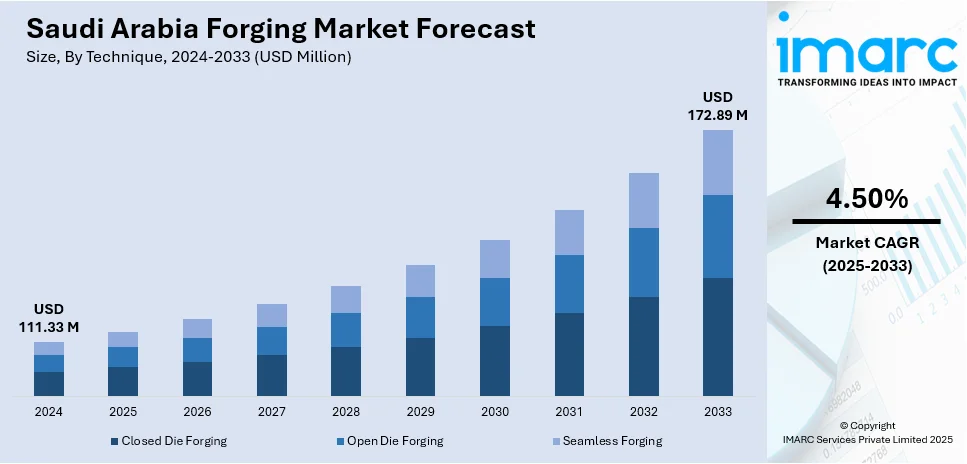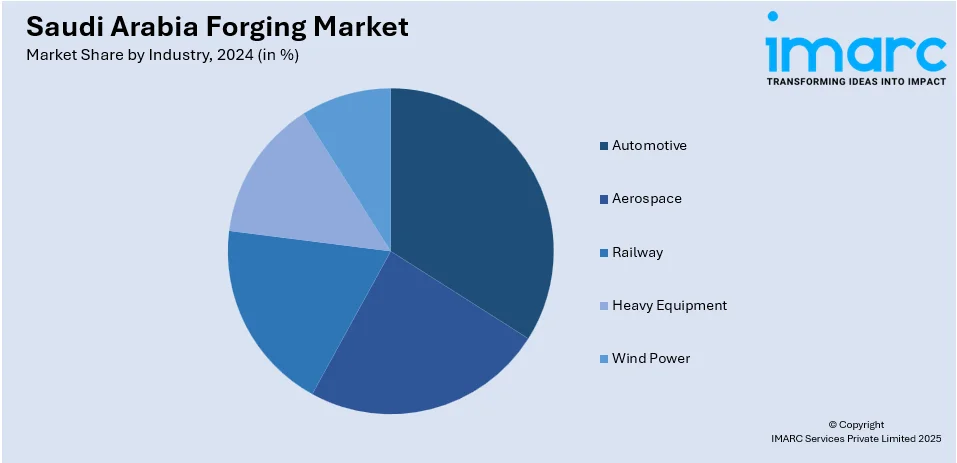
Saudi Arabia Forging Market Size, Share, Trends and Forecast by Technique, Material, Industry, and Region, 2025-2033
Saudi Arabia Forging Market Overview:
The Saudi Arabia forging market size reached USD 111.33 Million in 2024. Looking forward, IMARC Group expects the market to reach USD 172.89 Million by 2033, exhibiting a growth rate (CAGR) of 4.50% during 2025-2033. The expansion is driven by trends such as significant investments in infrastructure, rise in the consumption of high-performance components in the oil and gas sector, and expansion of the automobile industry. These trends drive the demand for forged products, thereby expanding the Saudi Arabia forging market share.
|
Report Attribute
|
Key Statistics
|
|---|---|
|
Base Year
|
2024
|
|
Forecast Years
|
2025-2033
|
|
Historical Years
|
2019-2024
|
| Market Size in 2024 | USD 111.33 Million |
| Market Forecast in 2033 | USD 172.89 Million |
| Market Growth Rate 2025-2033 | 4.50% |
Saudi Arabia Forging Market Trends:
Expanding Infrastructure and Construction Projects
Saudi Arabia's Vision 2030 has been the key driver of the country's large infrastructure and building projects, financially pushing the demand for forged steel. Megaprojects such as the Red Sea Project, Neom city, and industrial parks require high-grade forged components, including supports and beams, for structural support and safety. The local manufacturing effort by the government and focus on local production guarantee the use of forged steel produced within the country. For instance, the $4 billion steel plate manufacturing facility being developed by Aramco, Baosteel, and PIF in Ras al-Khair Industrial City, with an annual production capacity of 1.5 million tons, will strengthen the local steel industry and reduce CO2 emissions by as much as 60%. As these projects progress, the demand for durable and reliable forged components, critical in high-stress applications, is set to increase. This trend plays a major role in driving Saudi Arabia forging market growth.

Growth of the Automotive Industry
The rapid growth of Saudi Arabia's automotive industry is another contributing factor to the expansion of the forging market. For instance, as per industry reports, the Saudi government has allocated more than $5 billion to develop local automotive production facilities, collaborating with international manufacturers such as Lucid Motors and Hyundai. Moreover, by 2025, Saudi Arabia plans to produce over 300,000 vehicles per year, generating more than 27,000 jobs in the sector. Automotive applications demand a number of forged components, such as engine parts, suspension systems, and transmission systems, that must be of high performance, safety, and durability. With the progress in the industry, there is an inclination towards even more advanced materials, such as high-strength steel, to provide fuel economy and automotive safety. The government efforts to diversify its economy, increasing domestic demand, and an initiative for increased localization of auto manufacturing are bolstering the Saudi Arabia forging market growth. This growth will continue as the auto industry is at the forefront of the country's economic diversification.
Saudi Arabia Forging Market Segmentation:
IMARC Group provides an analysis of the key trends in each segment of the market, along with forecasts at the country/regional levels for 2025-2033. Our report has categorized the market based on technique, material, and industry.
Technique Insights:
- Closed Die Forging
- Open Die Forging
- Seamless Forging
The report has provided a detailed breakup and analysis of the market based on the technique. This includes closed die forging, open die forging, and seamless forging.
Material Insights:
- Nickel-based Alloys
- Titanium Alloys
- Aluminum Alloys
- Steel Alloys
A detailed breakup and analysis of the market based on the material have also been provided in the report. This includes nickel-based alloys, titanium alloys, aluminum alloys, and steel alloys.
Industry Insights:

- Automotive
- Aerospace
- Railway
- Heavy Equipment
- Wind Power
The report has provided a detailed breakup and analysis of the market based on the industry. This includes automotive, aerospace, railway, heavy equipment, and wind power.
Regional Insights:
- Northern and Central Region
- Western Region
- Eastern Region
- Southern Region
The report has also provided a comprehensive analysis of all the major regional markets, which include Northern and Central Region, Western Region, Eastern Region, and Southern Region.
Competitive Landscape:
The market research report has also provided a comprehensive analysis of the competitive landscape. Competitive analysis such as market structure, key player positioning, top winning strategies, competitive dashboard, and company evaluation quadrant has been covered in the report. Also, detailed profiles of all major companies have been provided.
Saudi Arabia Forging Market News:
- In February 2025, Ceer, a Saudi electric vehicle manufacturer, secured agreements worth SAR 5.5 billion, including partnerships with Saudi Aluminum Casting Co. and CTR to localize aluminum casting and forging. These initiatives support Vision 2030, enhancing domestic automotive manufacturing and supply chains, and driving demand for locally produced metal components in Saudi Arabia's casting and forging market.
- In 2024, Essar Group committed $4 billion to establish a low-carbon steel plant in Ras Al-Khair, Saudi Arabia. The facility is designed to produce 4 million tons of steel annually, addressing the increasing domestic demand, especially for large-scale infrastructure projects.
Saudi Arabia Forging Market Report Coverage:
| Report Features | Details |
|---|---|
| Base Year of the Analysis | 2024 |
| Historical Period | 2019-2024 |
| Forecast Period | 2025-2033 |
| Units | Million USD |
| Scope of the Report |
Exploration of Historical Trends and Market Outlook, Industry Catalysts and Challenges, Segment-Wise Historical and Future Market Assessment:
|
| Techniques Covered | Closed Die Forging, Open Die Forging, Seamless Forging |
| Materials Covered | Nickel-Based Alloys, Titanium Alloys, Aluminum Alloys, Steel Alloys |
| Industries Covered | Automotive, Aerospace, Railway, Heavy Equipment, Wind Power |
| Regions Covered | Northern and Central Region, Western Region, Eastern Region, Southern Region |
| Customization Scope | 10% Free Customization |
| Post-Sale Analyst Support | 10-12 Weeks |
| Delivery Format | PDF and Excel through Email (We can also provide the editable version of the report in PPT/Word format on special request) |
Key Questions Answered in This Report:
- How has the Saudi Arabia forging market performed so far and how will it perform in the coming years?
- What is the breakup of the Saudi Arabia forging market on the basis of technique?
- What is the breakup of the Saudi Arabia forging market on the basis of material?
- What is the breakup of the Saudi Arabia forging market on the basis of industry?
- What is the breakup of the Saudi Arabia forging market on the basis of region?
- What are the various stages in the value chain of the Saudi Arabia forging market?
- What are the key driving factors and challenges in the Saudi Arabia forging market?
- What is the structure of the Saudi Arabia forging market and who are the key players?
- What is the degree of competition in the Saudi Arabia forging market?
Key Benefits for Stakeholders:
- IMARC’s industry report offers a comprehensive quantitative analysis of various market segments, historical and current market trends, market forecasts, and dynamics of the Saudi Arabia forging market from 2019-2033.
- The research report provides the latest information on the market drivers, challenges, and opportunities in the Saudi Arabia forging market.
- Porter's five forces analysis assist stakeholders in assessing the impact of new entrants, competitive rivalry, supplier power, buyer power, and the threat of substitution. It helps stakeholders to analyze the level of competition within the Saudi Arabia forging industry and its attractiveness.
- Competitive landscape allows stakeholders to understand their competitive environment and provides an insight into the current positions of key players in the market.
Need more help?
- Speak to our experienced analysts for insights on the current market scenarios.
- Include additional segments and countries to customize the report as per your requirement.
- Gain an unparalleled competitive advantage in your domain by understanding how to utilize the report and positively impacting your operations and revenue.
- For further assistance, please connect with our analysts.
 Request Customization
Request Customization
 Speak to an Analyst
Speak to an Analyst
 Request Brochure
Request Brochure
 Inquire Before Buying
Inquire Before Buying




.webp)




.webp)












